Antimicrobial Resistance Market Research, 2032
The global antimicrobial resistance market size was valued at $4.6 billion in 2022, and is projected to reach $9.5 billion by 2032, growing at a CAGR of 7.6% from 2023 to 2032. Misuse and overuse of antibiotics is the major driving factor for the growth of the market. There is a high consumption of broad-spectrum antibiotics for the treatment of a wide range of bacterial infections globally. Main reason behind overprescribing of the antibiotics is the lack of effective regulations in the low- and middle-income countries and failure to implement the regulations over antibiotic usage. This further increases the demand for novel antibiotics which are used against resistant bacterial infections, thereby contributing to market growth.
There is an urgent need for novel and new antibiotics that can overcome this burden of antimicrobial resistance as the available antibiotics are becoming ineffective against the drug resistant bacteria. In addition, the cost of antimicrobial resistance to nation economies and the health systems is significant as it may lead to prolonged hospital stays, excessive cost and intensive care for treatment.
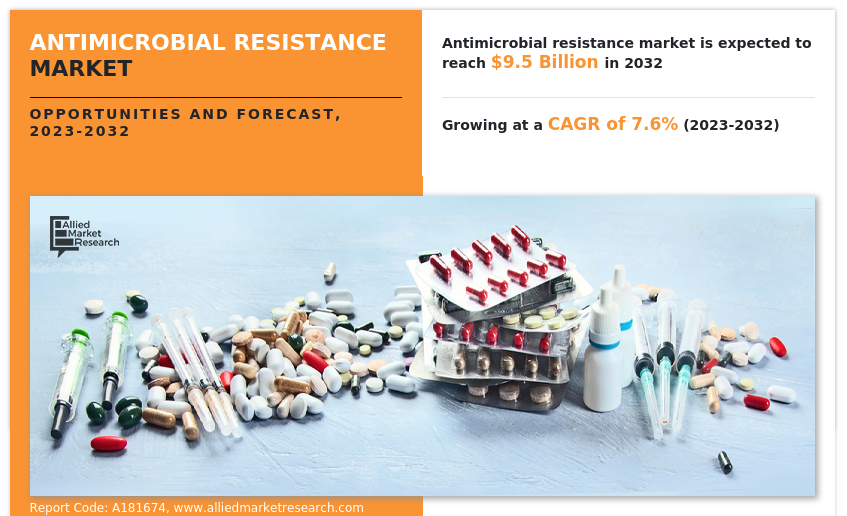
Antimicrobial resistance is referred to the resistance developed by the microorganism against various antimicrobials. Microbial species such as fungi, bacteria, viruses, and others show resistance to various drugs which is developed over a certain period. A pathogen may be resistant to a single drug or may be resistant to multiple drugs which is known to be multi-drug resistant bacteria or may sometimes referred as super bug (pan resistant bacteria). It becomes harder to treat the infections and there increases the risk of disease spread, severe illness and deaths as these resistant microbes do not respond to the available treatment.
Market Dynamics
Major factors that drive the growth of the antimicrobial resistance market size are the rising burden of antimicrobial resistance globally, misuse and overuse of antibiotics and increase in prevalence of bacterial infections that are hard to treat. There is a rise in global burden of antimicrobial resistance. This makes it difficult to treat the significant prevalence of antimicrobial resistant bacterial infections. The WHO has declared antimicrobial resistance as one of the 10 global public health threats. This highlights the rise in burden of antimicrobial resistance which demands the urgent need to develop novel antibiotics, thereby contributing to the growth of the market.
Furthermore, the rise in antimicrobial resistant bacterial infections contributes to the growth of the antimicrobial resistance market share. Bacterial infections such complicated urinary tract infections (cUTIs), Hospital acquired pneumonia or ventilator acquired pneumonia (HABP or VABP) and others are on the rise which is mainly caused due to the antimicrobial resistant bacteria. Such infections involve the bacteria which have become highly resistant to the drugs and hence have limited or no treatment options. This challenge is anticipated to be overcome by introducing new antibiotics that can be used to treat these infections. This is anticipated to contribute to the growth of the market.
In addition, key players in the market are focused on development and launch of new antibiotics which expands the market growth. Key players are offering a range of products such as Dificid, Recarbrio, Zerbaxa, Pifeltro & Delstrigo and others which are effective against resistant bacteria. This leads to the surge in adoption of these products by the people in the developed countries as well as some developing countries. Furthermore, the launch of products for treatment of complicated urinary tract infections and hospital acquired infections propels the growth of the market.
On the other hand, the high cost of these novel antibiotics acts as a restraint to the market growth. Development of new antibiotics is a challenge to the pharmaceutical sector due to the difficult research and development process and high expenses. No new antibiotics have been developed for years and the available antibiotics are ineffective against resistant bacteria. Thus, novel antibiotics have high cost and are to be used under stringent regulations, which may hinder the marker growth to some extent.
However, rise in awareness about antibiotic resistance and funding for the development of new antibiotics will offer lucrative opportunities for the growth of the market. There is a significant investment by the government and healthcare sector for the development of novel and new antibiotics that can overcome bacterial resistance. In addition, collaboration and partnerships are carried out by the key players to invent new formulations which may boost the antimicrobial resistance market share during the forecast period.
The ongoing global recession had a significant effect on various industries including pharmaceutical and biotechnology industries. Reduced funding in sectors such as pharmaceuticals, biotechnology and chemicals has led to fluctuations in development for novel antibiotics. Moreover, it impacted the purchasing decisions for costly medications, potentially affecting the adoption of novel antibiotics.
Segmental Overview
The antimicrobial resistance market is segmented on the basis of drug class, pathogen, indication, mechanism of action, and region. On the basis of drug class, the market is classified into combination therapies, tetracyclines, cephalosporins, glycopeptides and lipoglycopeptides, oxazolidinones, and others. On the basis of pathogen, the market is segmented into Escherichia coli, Klebsiella pneumoniae, Pseudomonas aeruginosa, Staphylococcus aureus, Enterococcus spp, and others.
On the basis of on indication, the market is segmented into complicated urinary tract infections (cUTI), blood stream infections, acute bacterial skin and skin structure infections (ABSSSI), hospital acquired bacterial pneumonia and ventilator acquired bacterial pneumonia (HABP and VABP), community acquired pneumonia (CAP), and others. On the basis of mechanism of action, the market is categorized into protein synthesis inhibitors, cell wall synthesis inhibitors, and others.
On the basis of region, the market is analyzed across North America (the U.S., Canada, and Mexico), Europe (Germany, France, the UK, Italy, Spain, and rest of Europe), Asia-Pacific (China, Japan, Australia, India, South Korea, and rest of Asia-Pacific), and LAMEA (Brazil, South Africa, Saudi Arabia, and rest of LAMEA).
By Drug Class
On the basis of drug class, the combination therapies segment dominated the market in terms of revenue in 2022. The growth of the segment is mainly attributed to the application of combination medications in the treatment of a wide range of bacterial resistant infections. Combination therapies such as Recarbrio, Vabomere and others are used in the treatment of infections such as complicated urinary tract infections (cUTI), complicated intra-abdominal infections (cIAI) and others.
On the other hand, the others segment is anticipated to be the fastest growing segment duringt he forecast period which is attributed to the rise in demand of the infected population, the key players are actively working on development, approval and launch of these medications in the market. This further foster antimicrobial resistance market growth.
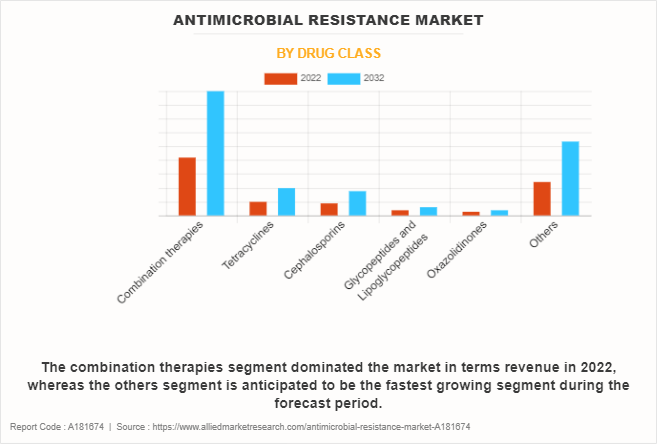
By Indication
On the basis of indication, the complicated urinary tract infection segment dominated the market in terms of revenue in 2022, which is attributed to the rise in prevalence of complicated urinary tract infections among people around the globe. In addition, spread of antimicrobial resistant species and inefficacy of available antibiotics to treat the rise in resistant bacteria urinary tract infection increases the demand for new novel antibiotics for the treatment. This boosts the growth of cUTI segment.
On the other hand, the hospital acquired pneumonia and ventilator acquired pneumonia (HABP & VABP) segment is anticipated to be the fastest growing segment during the forecast period. This growth is mainly due to the rise in burden of hospital acquired infections and lack of sanitation in the hospitals and other healthcare institutions.
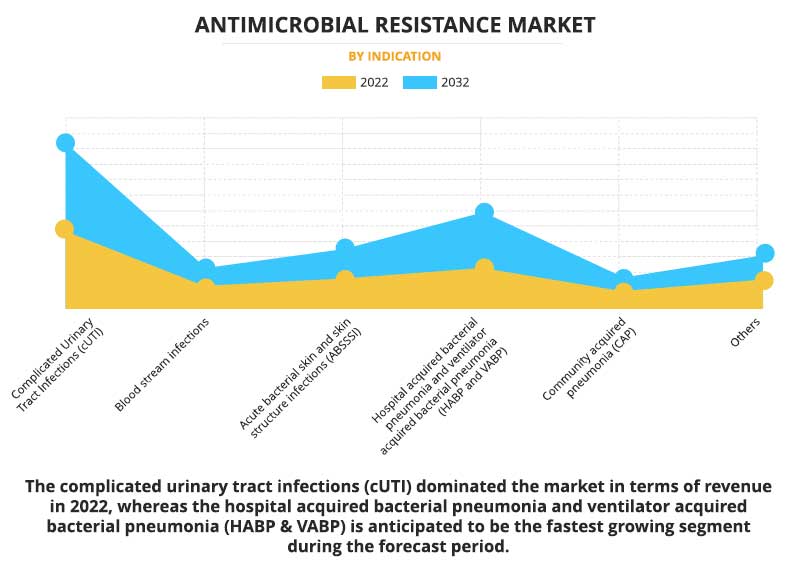
By Pathogens
On the basis of pathogen, the E. coli segment dominated the market in 2022 in terms of revenue, which is attributed to the rise in prevalence of bacterial infections caused due to drug resistant E. coli. Infections such as sepsis, urinary tract infections (UTIs), pneumonia, meningitis and others are on the rise and available medications are ineffective against them due to the drug resistant nature of the pathogen.
On the other hand, Klebsiella pneumoniae segment is anticipated to be the fastest growing segment owing to the rise in burden of hospital acquired infections such as Hospital-acquired bacterial pneumonia and ventilator acquired bacterial pneumonia (HABP & VABP). For instance, according to the National Library of Medicine (NLM), K. pneumoniae accounts for approximately 11.8% of all hospital-acquired pneumonia in the world.
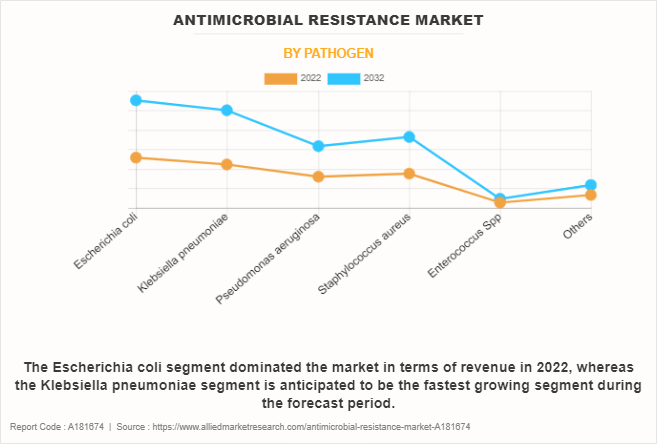
By Mechanism of Action
On the basis of mechanism of action, the cell wall synthesis inhibitors segment dominated the market in 2022 and is anticipated to be the fastest growing segment during the forecast period. This growth is mainly attributed to the surge in development and launch of products such as Zerbaxa, Avycaz, Vabomere and others which show action by inhibiting cell wall synthesis.
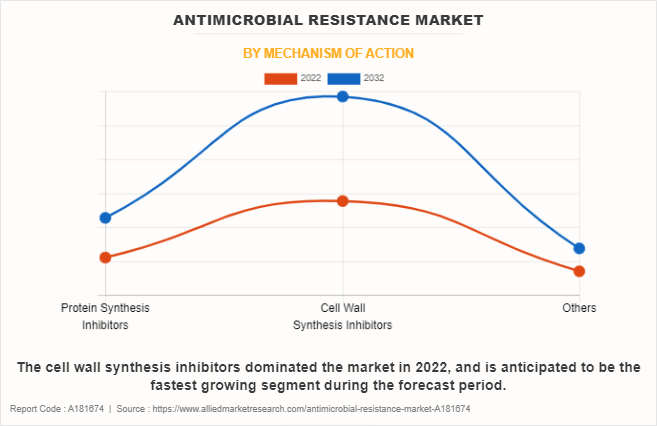
By Region
North America accounted for a major share of the antibiotic resistance market in 2022 and is expected to maintain its dominance during the forecast period. The presence of several major players, such as Innoviva, Inc., Pfizer Inc., Merck & Co., Inc., and others is contributing on a significant scale to the growth of the market in North America. In addition, well developed healthcare infrastructure and launch of various novel antibiotics in U.S. is leading to the expansion of the market.
On the other hand, Asia-Pacific is expected to witness growth at the highest rate during the antimicrobial resistance market forecast period. There is a high burden of antimicrobial resistance in Asian countries due to the excess and misuse of antibiotics in countries such as India and China. In addition, rising awareness about antimicrobial resistance among the population leads to the increase in adoption of novel antibiotic medication which are effective in treatment of drug resistant bacterial infections.
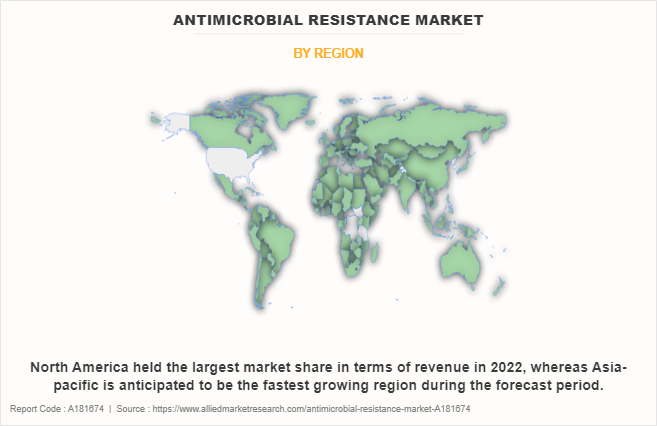
Competition Analysis
Competition analysis and profiles of the major players in the antimicrobial resistance industry, such as Alkem Laboratories Ltd, Innoviva, Inc., Pfizer Inc., Merck & Co., Inc., Acurx Pharmaceuticals, Inc., Basilea Pharmaceutica Ltd, Cumberland Pharmaceuticals Inc., Wockhardt Limited, Paratek Pharmaceuticals, Inc. and Nabriva Therapeutics plc. Major players have adopted product approval, collaboration, funding, acquisition, product upgrade/development, and product launch as a key developmental strategy to improve the product portfolio and gain strong foothold in the antimicrobial resistance industry.
Recent Developments in the Antibiotic Resistance Market
- In July 2020, Nabriva Therapeutics plc announced that its partner, Sunovion Pharmaceuticals Canada Inc., has received approval from Health Canada to market oral and intravenous (IV) formulations of Xenleta (lefamulin) for the treatment of community-acquired pneumonia (CAP) in adults.
- In January 2023, Alkem Laboratories Ltd. launched its novel anti-infective in India under the brand name Zidavi a potential therapeutic option for the treatment of infections complicated by multi-drug resistant (MDR) organisms.
- In April 2021, Pfizer Inc. acquired Amplyx Pharmaceuticals, Inc., a privately held company involved in development of therapies for debilitating and life-threatening diseases that affect people with compromised immune systems with its lead compound Fosmanogepix (APX001).
Key Benefits for Stakeholders
- This report provides a quantitative analysis of the market segments, current trends, estimations, and dynamics of the antimicrobial resistance market from 2022 to 2032 to identify the prevailing antimicrobial resistance market opportunity.
- The market research is offered along with information related to key drivers, restraints, and opportunities.
- Porter's five forces analysis highlights the potency of buyers and suppliers to enable stakeholders make profit-oriented business decisions and strengthen their supplier-buyer network.
- In-depth analysis of the antimicrobial resistance market segmentation assists to determine the prevailing market opportunities.
- Major countries in each region are mapped according to their revenue contribution to the global market.
- Market player positioning facilitates benchmarking and provides a clear understanding of the present position of the market players.
- The report includes the analysis of the regional as well as global antimicrobial resistance market trends, key players, market segments, application areas, and market growth strategies.
Antimicrobial Resistance Market Report Highlights
| Aspects | Details |
| Market Size By 2032 | USD 9.5 billion |
| Growth Rate | CAGR of 7.6% |
| Forecast period | 2022 - 2032 |
| Report Pages | 389 |
| By Indication |
|
| By Drug Class |
|
| By Mechanism of Action |
|
| By Pathogen |
|
| By Region |
|
| Key Market Players | Acurx Pharmaceuticals, Inc., Wockhardt Limited., Paratek Pharmaceuticals Inc, Cumberland Pharmaceuticals, Innoviva, Inc, Basilea Pharmaceutica Ltd, Pfizer Inc., Nabriva Therapeutics plc, Alkem Laboratories Ltd., Merck & Co., Inc. |
Analyst Review
The growth of global antimicrobial resistance market is attributed to factors such rise in R&D in pharmaceutical sector to tackle antimicrobial resistance globally. AMR poses a significant risk to patient care, leading to treatment failures, prolonged illnesses, and increased healthcare costs. There are initiatives taken by the government and key players for developing novel antibiotics that are effective against antimicrobial-resistant bacterial infections, to overcome this global threat.
The AMR crisis highlights novel therapies and technologies to combat drug-resistant infections. Investment in R&D has increased to uncover new antibiotics and alternative treatment modalities. In addition, rise in incidences of healthcare-associated infections such as complicated urinary tract infections (cUTI), acute bacterial skin and skin structure infections (ABSSSI), and hospital-acquired bacterial pneumonia and ventilator acquired bacterial pneumonia (HABP & VABP) boosts the antimicrobial resistance market growth.
Furthermore, North America witnessed the highest growth in 2022, in terms of revenue, owing to the recent drug approvals in this region for treating antimicrobial resistant bacterial infections. However, Asia-Pacific is expected to exhibit the fastest growth during the forecast period owing to the huge population base and high prevalence of bacterial infection in this region.
The base year is 2022 in antimicrobial resistance market.
The forecast period for antimicrobial resistance market is 2023 to 2032.
The total market value of antimicrobial resistance market is $4.6 billion in 2022.
The market value of antimicrobial resistance market in 2032 is $9.5 billion.
Major players that operate in the antimicrobial resistance market are Alkem Laboratories Ltd, Innoviva, Inc., Pfizer Inc., Merck & Co., Inc., Acurx Pharmaceuticals, Inc., Basilea Pharmaceutica Ltd, Cumberland Pharmaceuticals Inc., Wockhardt Limited, Paratek Pharmaceuticals, Inc., and Nabriva Therapeutics plc.
The combination therapies segment is the most influencing segment in the market owing to the surge in research activities related to combination drugs and significant product launches in the market.
Key factors driving the growth of the antimicrobial resistance market includes overuse and misuse of antibiotics, rise in prevalence of antimicrobial resistance bacterial infections and growth in burden of antimicrobial resistance.
Asia-Pacific has the highest growth rate in the market with 8.4% CAGR owing to to rise in investments by the key players in production and development of treatment for antimicrobial resistant bacterial infections, and high usage of antibitoics in this region.
Loading Table Of Content...
Loading Research Methodology...


